Cairo is one of these megapolis of the third world, which have to face up the negative effects of an ever-growing urban population. These include excessive amounts of waste, which of course, Cairo like any other Capital city produces. It seems, that people of Cairo invented spontaneous recycling cycle system which is able to sort unbelievable one-third of waste across Cairo. Accidentally, I witnessed this recycling cycle some years ago. It was during the winter semester at the University of West Bohemia in Pilsen, on September 2011, and I had unique opportunity to travel on one month in Egyptian Cairo. The students from the University received a little contribution to cover the cost of the plane ticket to the Cairo. So I was so thrilled that the intensive studying of Arabic language will not be so expensive matter.

I travelled at that time with other students who were interested in studying Arabic in Cairo and thus we stepped into another world. (Another story from Cairo see Blog). We had a free weekends so I tried to discover most of the places of Cairo. I cannot remember when and who told me about garbage collectors, or whether I had heard something about them at one of the university lectures, anyway, the only thing I knew was that garbage collectors exist and I really wanted to know and see them.
Forasmuch as, it was not exactly kind of the trips for those students who were looking for ancient treasures of Cairo, so our ´explore´ team include just me and two other classmates from Middle East studies. The only thing that I really had set was my camera (even a quick check whether it is charged), and quickly stop the first taxi driver that swoop around you in the streets of Cairo. I remember as if it were today, that the taxi driver was shooking his head in disbelief, that where this group of well-dressed European students wanted to take away. ´Are you sure, that you want there?!´ ´Would you prefer to take on Zamalek1.Zamalek is an urban district, the part of the Great Cairo. Zamalek lies on the Gezira Island (in Arabic literally Island) in the Nile Delta. Zamalek is mainly known for its more relaxed and refined atmosphere, with many cafes, green parks and sports areas. Many Westerners live in this part. People are engaged in leisure activities, like jogging or walking for the dogs. There are also available veterinary clinic for pets.?!´
´No, no, no!´ we speak unified votes, we are going straight to the Garbage city! The classmate, who already was a long time in Cairo, was sitting next to the driver, in the passenger seat, and tried for a polite conversation that would have perhaps led from his narrow puzzled expression in face, let up a bit suspicious way. He still did not understand (and, frankly, quite possibly still does not understand) what we went there to look for. Our conversation failed. First of all, the Egyptian Arabic (Masri) is a far away from what we learned at school (al-Fusha), so we did not understand him so much. Secondly, he disobeyed our questions about ´his country and culture´. He still was looking at us and gauged us in the spring-back mirror. After a few minutes he braked sharply, the engine was still grumbling and gruffly muttered: ´You are here.´ He took from us a few Egyptian pounds for the ride and he left us like a lightning speed.
Such an interesting start, I thought. When we got out and stood just behind a post road we were not sure if it is ´the´ place. Somehow that area was not so different from another urban Cairo district with shantytown. However, my view of the left side of the elevated slope of the road signalled that we are in right place. There was big pile of garbage from everywhere from Cairo and also was stenched…

We were on the spot – in Manshiyat Naser, also so-called in Garbage City, ranging on the foothill of Mokattam Hill. Manshiyat Naser is known for that there are people who are called by other Egyptians Zabbaleen. The word Zabbaleen is derived from Egyptian Arabic (زبالين) and in translation is means simply ´garbage collectors´. The garbage collectors are calling themselves Zarabba, ´pig owners´. From Islamic religion view is pig farming strictly prohibited and it is clear that Zabbaleen people are not worshipping Islam. It follows that they are Copts and profess Orthodox Christianity. Even though many years have been Manshiyat Naser mostly Coptic area, the growing Muslim population has considerable numbers here.

First of all we went to the Muslim part that surrounded the central Coptic section. Except for a few lounging litters, we did not find this section – nothing special, so at this time we didn´t understand why Manshiyat Naser is so-called the Garbage City. People were in a hurry, walking around the road from beaten earth, stopping at stalls with outdoor shops that offer vegetables, fruits or even live chickens and young chicks. One member of our excursion who had spent a long time in Cairo, bought in a outdoor shop a handful of mint chewing gum and gave a few leaves into his mouth, saying that in Cairo you can really eat everything, everywhere and under all circumstances. With the enthusiastic expression chewed mint leaves and tried us Greenhorns encourage a similar attitude.

After a long walk through Manshiyat Naser we began to wander the narrow streets and we started noticing the commotion that we are called out. Three European tourists amazement staring at Manshiyat Naser residents, including one crazy girl, who must take many photos. My fervent shooting tremendously pleased leaping flock of children who surrounded me and wanted at all costs to attract my attention. I admit quite openly that kids did not have to persuaded so long – big dark eyes sparkling with enthusiasm from special visitors acted absolutely dismantle impression, so we started to play a game. The game was so simple, take a picture of who and how, with whom, or who more times I took the photo.

While I glued my camera to my left eye and watched the world from behind the photographic window, my schoolmates decided to address a few of words the passers by to find the right way into the center of Garbage Ciy. I followed them and went behind them with ´my´ group of children and I was continuing with our game of capturing the best photo.
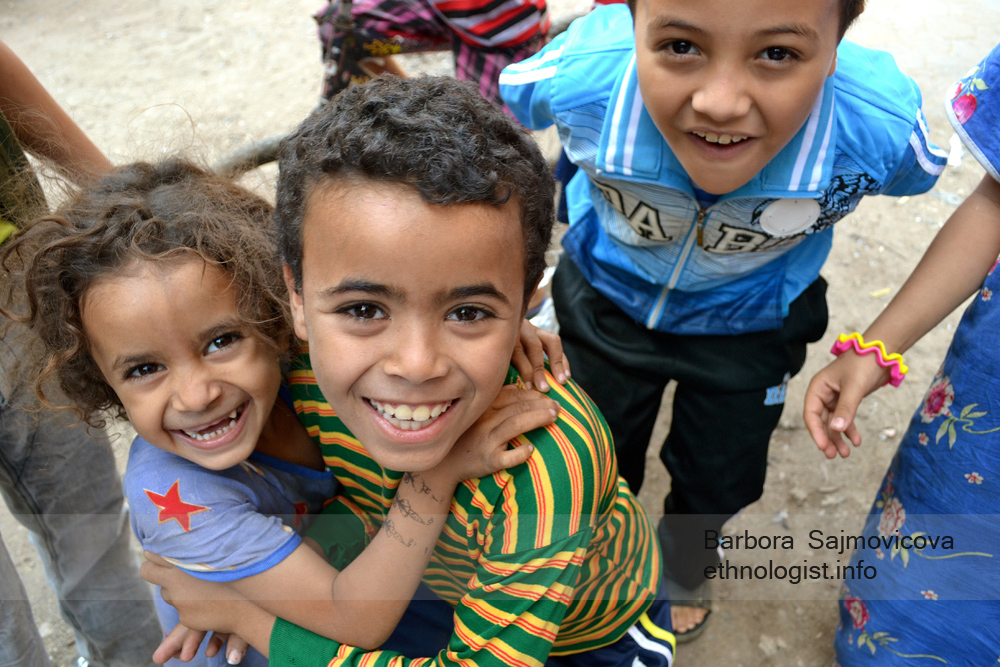
We were walking through the streets of Manshiyat Naser and I could not help but notice the ubiquitous human efforts that had built at least a little friendly world in this environment of immense poverty. So, we passed, in addition to home-built shops with food, shops also offering a variety of services, for example a car and cycle repair shop.
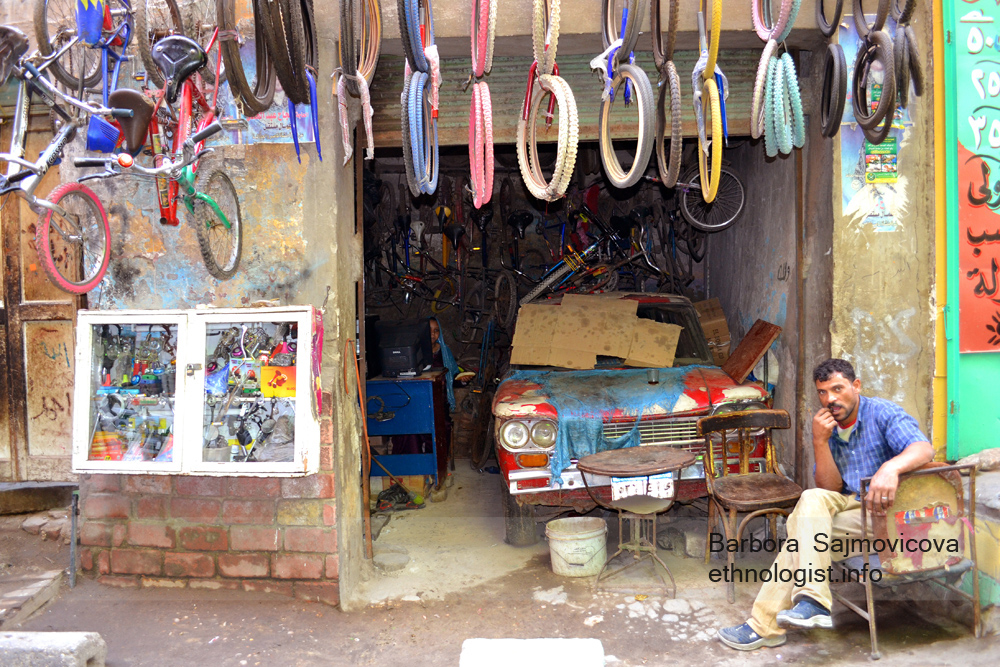
After some time wandering the streets and taking photos of the local people of Manshiyat Naser, a local ´Sheik´ spotted us. On first sight, he appeared to be a godly man, whose serious and penetrating look chased a crowd of children away and he started to explain to us that we have to go after him, that will lead us ´there, where you want´. He irradiated a sort of ineffable authority, and I wanted to capture a photo of him, how he was leading us straight to the Garbage City. However, the Sheikh turned to me seriously and explained that I could not just take pictures of him ´here´ – in such misery. ´I do not want you to capture the misery that surrounds me and others.´ Nevertheless I was not put off by his words and I asked him again later. We stuck closely to his back as we walked through a narrow alley linking the mostly Muslim part with the Christian part of Garbage City.

After we passed through a narrow alley, we found ourselves in a genuinely Christian district. At this time, the Sheik decided that he would dedicate one photo for me. He chose an appropriate place, a tailor shop of his good friend, a Christian friend. Surprisingly, it was the place where he felt most proud to be who he is and where he is. And I am still very grateful for this picture now…
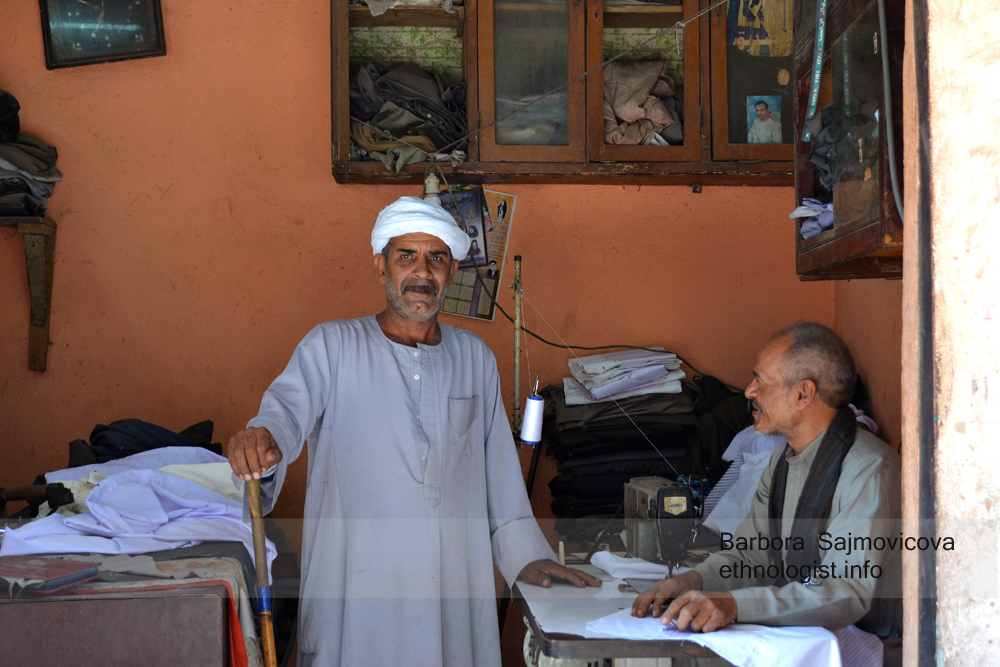
The Sheikh thought that we had strayed into the Garbage City for the famous Coptic monuments (thus not for the garbage collectors), but I did not have the slightest idea that something like that was located in this area. So, he led us right to the entrance of the church of Saint Simon the Tanner. Before entering the square in front of the church he said goodbye and wished us luck with a shake of his head, refusing any tips that we had offered to him for his kindness, and he went away. The view of the square and the Church of Saint Simon was really unforgettable. It is a truly marvellous church, which is surrounded by a large square without the slightest speck of dirt or litter, which was such a big contrast to the rest of Garbage City. I felt like we had passed the imaginary threshold of M. Eliade, connecting the space between profane and sacral.
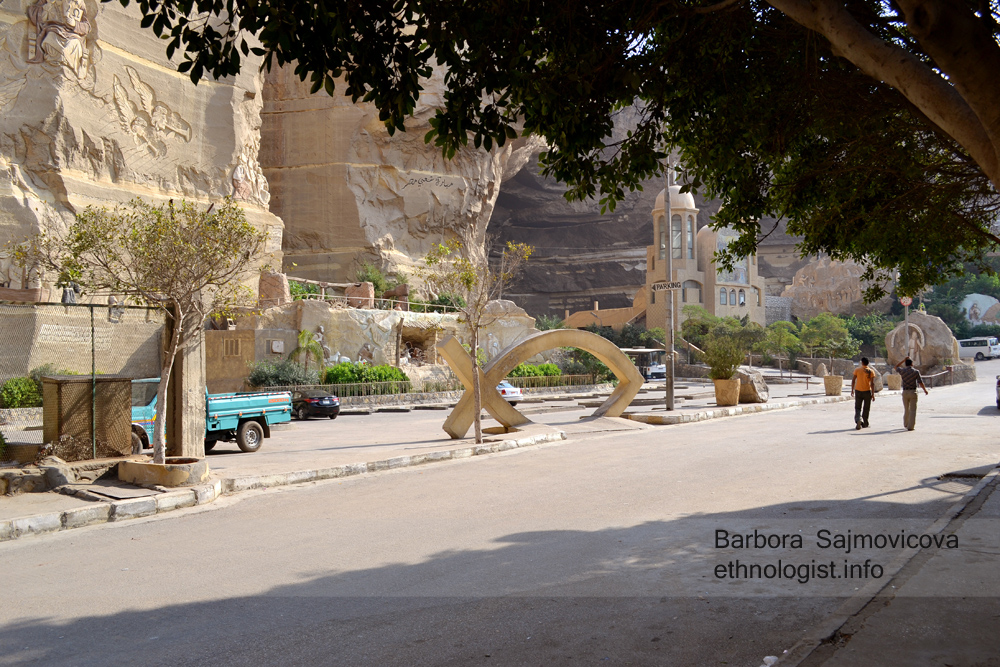
The breath-taking church is hidden at the foot of the Mokattam Hill, whose slope is decorated with sculpted Christian scenes of Jesus Christ, the Virgin Mary, angels and mapping of the Holy Nativity and the way of the Holy family to the Egypt. This unusual decor and the Cave Church attracts the ´informed´ tourists to wander here, including believers from around the world.

The Church of Saint Simon played an important role in the religion and social life of the garbage collectors. The Church was built in 1975 and was, as we would come to know later, an influential moment and seen as a symbol of assurance and perseverance. The settlement of the garbage collectors was established in 1969, when the other garbage collectors were evicted from other parts of Cairo and relocated to this place. The people perceived the building of the Church as a signal for the beginning of real life and settling down without the feelings of doubt connected with many previous evictions. Since these days the garbage collectors have started building houses from more permanent materials.

The Church of Saint Simon is not one of many churches – conversely, it is outstanding and unique: this is the largest church in the Middle East with the capacity for 20, 000 people. It follows that many important social events take place in this church.

Many of the people who visit the Church of Saint Simon want to witness the miracle, which Saint Simon did in the centre of the church, near his holy paintings. As told to me by a local Christian, who befriended and guided us to the Church; he pointed to the wheelchair for the disabled which was folded up at one of the church walls and explained to us that left it there by a man, who was healed and walked from the church on his own feet. The Christian saw our curious expressions on our faces and he continued: “You can come this Thursday – every Thursday miracles happen in this church.” Now we looked more and began to ask questions about the details. However, we did not get much more out of him. What I really know is that Saint Simon does miracles and heals the people, but I have to go on Thursday…

We noticed a few tourists in the Church, passing by the Holy paintings of Jesus Christ, the Virgin Mary, angels and mainly portraits of Saint Simon. I viewed his pictures and I was thinking about this miraculous Saint. Thoughts were running through my head and still I was wonderstruck: “Should we come on Thursday to view the miracle?” I said to myself. After a moment of wondering silence and thinking, the Christian again approached us and explained who Saint Simon was and how he had done miracles during his life…

Saint Simon is nicknamed the Tanner and he lived in 10th century Egypt, during the reign of Fatimid Caliph al-Mu´izz (953-975) and the office of Patriarch Abraham of Alexandria. Simon was a craftsman, he made shoes from leather and he had only one eye. That is because Saint Simon, in the purest Christian faith, followed a biblical interpretation of Mathew: ´ If your right eye causes you to stumble, gouge it out and throw it away. It is better for you to lose one part of your body than for your whole body to be thrown into hell.´ So, Saint Simon poked his right eye out and for this reason he is traditionally portrayed with one left eye, holding a leather bag with water, which is carried for the sick and needy people.

The healing of ill people by Saint Simon was not only his main faculty. It is generally considered that the biggest miracle of Saint Simon was lifting the mountain of Mokattam. The Coptic legend says, that one day Caliph Mu´izz, accompanied by troops and the Patriarch Abraham with his followers, met at the foot of the mountain. This meeting took place because three days before the Caliph had tested Patriarch Abraham in his faith and hinted to the Mathew parable about the mustard seed. Patriarch Abraham had been praying diligently for three days and three nights to the Virgin Mary. On the last night, the Virgin Mary appeared to him in a dream and gave him an inspiration that he should seek out the Saint Simon. The Patriarch Abraham did as he was told and sought out the Saint. The Saint gave advice to Patriarch that he should make an appointment with the Caliph under the Mokattam mountain and at that place he should call out three times: ´Oh Lord, have mercy!´ and point to the mountain with a crucifix. The Patriarch Abraham did exactly what the Saint had advised him. In the third beseeching call, a crack started in the mountain and it lifted. The Patriarch Abraham was astonished and he moved back to Saint Simon because he wanted to thank the Saint. Surprisingly, the Saint had disappeared and according to the legend nobody has ever seen him again. Deeply impressed, the Caliph al-Mu´izz went to the Patriarch and he said: ´Oh Patriarch, now I know the righteousness of your faith.´
The Coptic legends from this moment are divided. Some said that Caliph Mu´izz was so struck by the miracle that he immediately converted to Christianity, renouncing claims to the Caliph in favour of his son and spending the rest of his life in a monastery. On the other hand, this story was strictly rejected by Muslim historians. Whether the Coptic legend is right or nor, it managed to record the lives of three prominent real historical figures, living in Cairo at the end of the 10th century. The reign itself of Shi´ite Fatimid Caliph Mu´izze is generally considered to be a period where the Egyptian Copts enjoyed significant religious freedom and were allowed a number of rights. And who knows? Perhaps because the Caliph witnessed this Christian miracle…

After visiting the Church we all said goodbye to the Christian guide and also to the miracles of the Church of St. Simon hidden in the mountain of Mokattam. We walked away to the entrance gate to the Garbage City, which surrounds the Church of St. Simon. Although it does not seem at first that the houses of the garbage collectors differs from smaller tenements in other parts of Cairo, often they are without running water, electricity or even a waste water supply. The buildings of the garbage collectors closer to the Church of St. Simon have posters with Christian motifs of Jesus Christ.



Even when I returned from Garbage City, I learned that the early history of the garbage collectors is connected with smaller waves of migration during the second half of the 20th century, when low-income families travelled wilfully to Cairo for work. They settled on various locations in Cairo (including the settlement of Mokattam) and in a very subtle way, the newcomers have created so-called ´informal system of waste collection´. Garbage collectors walked around with their trucks (driven manually or by donkeys) in the streets of Cairo and went to the households where they picked up garbage daily. The Cairo families gave them a small fee for surrendering the waste and the garbage collectors travelled with full wagons back to their neighbourhood. There they carefully sorted out the waste which was then sold to small businesses and redeemed for materials such as iron, glass, plastics or paper.

As we walked through the streets of Garbage City among the piles of garbage protruding to a height of several metres, from downtown Cairo, we passed each family who sorted out mountains of garbage with their own hands every day. Like yesterday, and today, and tomorrow. One family is focused on paper, the other on textiles, and another still, on iron or glass.

The children scurried barefoot or in open slippers on the earthen path and chased each other through the landfill odour. Two or three goats were nearby, munching the waste paper as if it were a piece of grass, which nowhere in sight. Despite this strong smell of waste and visible filth and misery there were happy big dark eyes sparkling, accompanied by broad smiles on the children´s faces and their parents´. Everyone laughed at me, children were happily hopping and trying to get my attention again – to become the subject of my photos. There another world opened me to, more poor and needy than a man can imagine, but the hearts of these people were warm and looked into my eyes in an honest way. They were dedicated to their daily duties and I think they were some of the most open people that I have ever met.

Despite the poor living conditions, it does not seem that the garbage collectors perceive themselves as ´unclean´ or perhaps inferior. On the contrary, many authors dealing carefully with the communities agree that the garbage collectors are proud of their work, because they manage, very efficiently and economically, to sort an incredible one-third of the entire waste of the Cairo metropolis. However, with the growing privatization process in Egypt, there has been a decrease in garbage collecting by hand. The Egyptian authorities sold the municipal waste to multinational companies and they have taken over the entire process of waste treatment. Despite this fact, the garbage collectors have not completely disappeared from Cairo, although admit that this has had a big effect on ´their economy´.

Moreover, another important trade commodity for the Zabbaleen people was the breeding and selling of pigs. The pigs were in fact also an important part of the recycling cycle because they processed organic waste. Subsequently, the pigs were sold across Egypt for the benefit of the other Copts. However, in 2009, in response to the global panic from so called ´swine flu´, the Egyptian government cracked down on these communities of Copts. Pigs were slaughtered en masse. According to the many independent observers it was just a pretext, which would deliver a further blow to the Coptic community living in the Egypt.
In conclusion, with the takeover of the waste processing by international companies, many of the garbage collectors have to find a job in another sector. The children of the garbage collectors want to be educated and to have a good livelihood. However, among millions of others in the Cairo metropolis, this is not an easy task. On the other hand, it is possible that in the next few decades, this word Zabbaleen and their craft will disappear and become something from the past.
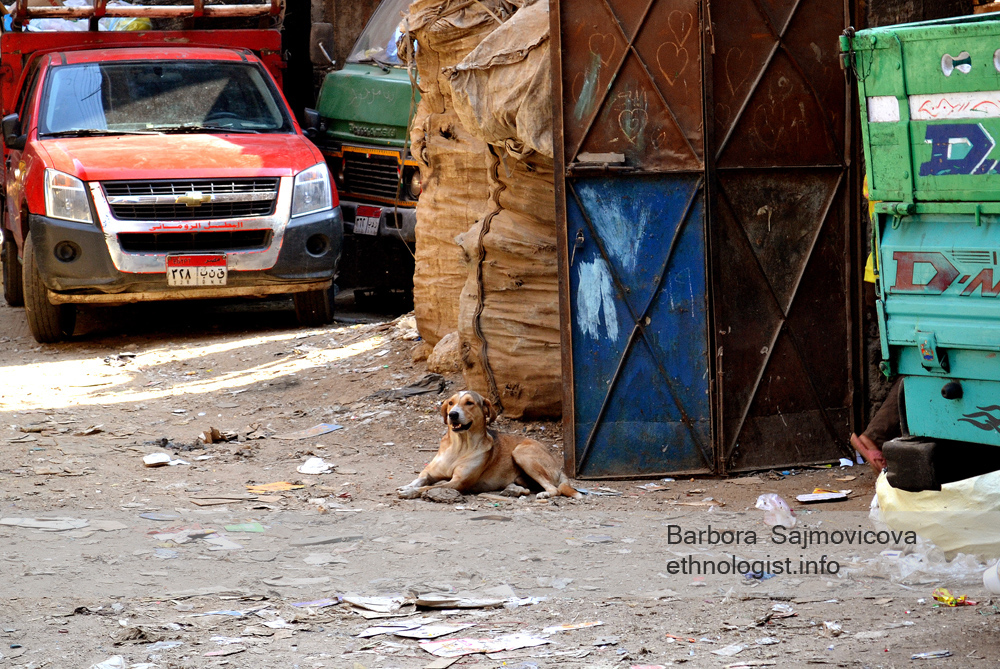
Additional literature:
Butter, Inge: An Informal Waste Management System in Cairo: The garbage collectors and their settlements. Doctoral Thesis, Leiden, 2006.
| ↑1 | Zamalek is an urban district, the part of the Great Cairo. Zamalek lies on the Gezira Island (in Arabic literally Island) in the Nile Delta. Zamalek is mainly known for its more relaxed and refined atmosphere, with many cafes, green parks and sports areas. Many Westerners live in this part. People are engaged in leisure activities, like jogging or walking for the dogs. There are also available veterinary clinic for pets. |
|---|